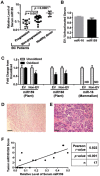Cross-kingdom inhibition of breast cancer growth by plant miR159
- PMID: 26794868
- PMCID: PMC4746606
- DOI: 10.1038/cr.2016.13
Cross-kingdom inhibition of breast cancer growth by plant miR159
Abstract
MicroRNAs (miRNAs) are critical regulators of gene expression, and exert extensive impacts on development, physiology, and disease of eukaryotes. A high degree of parallelism is found in the molecular basis of miRNA biogenesis and action in plants and animals. Recent studies interestingly suggest a potential cross-kingdom action of plant-derived miRNAs, through dietary intake, in regulating mammalian gene expression. Although the source and scope of plant miRNAs detected in mammalian specimens remain controversial, these initial studies inspired us to determine whether plant miRNAs can be detected in Western human sera and whether these plant miRNAs are able to influence gene expression and cellular processes related to human diseases such as cancer. Here we found that Western donor sera contained the plant miRNA miR159, whose abundance in the serum was inversely correlated with breast cancer incidence and progression in patients. In human sera, miR159 was predominantly detected in the extracellular vesicles, and was resistant to sodium periodate oxidation suggesting the plant-originated 2'-O-methylation on the 3' terminal ribose. In breast cancer cells but not non-cancerous mammary epithelial cells, a synthetic mimic of miR159 was capable of inhibiting proliferation by targeting TCF7 that encodes a Wnt signaling transcription factor, leading to a decrease in MYC protein levels. Oral administration of miR159 mimic significantly suppressed the growth of xenograft breast tumors in mice. These results demonstrate for the first time that a plant miRNA can inhibit cancer growth in mammals.
Figures






Similar articles
-
Increased erbB3 promotes erbB2/neu-driven mammary tumor proliferation and co-targeting of erbB2/erbB3 receptors exhibits potent inhibitory effects on breast cancer cells.Int J Clin Exp Pathol. 2015 Jun 1;8(6):6143-56. eCollection 2015. Int J Clin Exp Pathol. 2015. PMID: 26261492 Free PMC article.
-
Integration of microRNA signatures of distinct mammary epithelial cell types with their gene expression and epigenetic portraits.Breast Cancer Res. 2015 Jun 18;17(1):85. doi: 10.1186/s13058-015-0585-0. Breast Cancer Res. 2015. PMID: 26080807 Free PMC article.
-
Sequence and expression differences underlie functional specialization of Arabidopsis microRNAs miR159 and miR319.Dev Cell. 2007 Jul;13(1):115-25. doi: 10.1016/j.devcel.2007.04.012. Dev Cell. 2007. PMID: 17609114
-
Plant microRNAs and development.Int J Dev Biol. 2005;49(5-6):733-44. doi: 10.1387/ijdb.052015sj. Int J Dev Biol. 2005. PMID: 16096978 Review.
-
MicroRNA gene regulation cascades during early stages of plant development.Plant Cell Physiol. 2010 Nov;51(11):1840-6. doi: 10.1093/pcp/pcq154. Epub 2010 Oct 11. Plant Cell Physiol. 2010. PMID: 20937608 Review.
Cited by
-
Insights into Mobile Small-RNAs Mediated Signaling in Plants.Plants (Basel). 2022 Nov 18;11(22):3155. doi: 10.3390/plants11223155. Plants (Basel). 2022. PMID: 36432884 Free PMC article. Review.
-
Cross-kingdom regulation by plant-derived miRNAs in mammalian systems.Animal Model Exp Med. 2023 Dec;6(6):518-525. doi: 10.1002/ame2.12358. Epub 2023 Dec 8. Animal Model Exp Med. 2023. PMID: 38064180 Free PMC article. Review.
-
In Vivo Imaging for the Visualization of Extracellular Vesicle-Based Tumor Therapy.ChemistryOpen. 2022 Sep;11(9):e202200124. doi: 10.1002/open.202200124. ChemistryOpen. 2022. PMID: 36101512 Free PMC article. Review.
-
SIDT1-dependent absorption in the stomach mediates host uptake of dietary and orally administered microRNAs.Cell Res. 2021 Mar;31(3):247-258. doi: 10.1038/s41422-020-0389-3. Epub 2020 Aug 17. Cell Res. 2021. PMID: 32801357 Free PMC article.
-
Delineating effect of corn microRNAs and matrix, ingested as whole food, on gut microbiota in a rodent model.Food Sci Nutr. 2020 Jun 23;8(8):4066-4077. doi: 10.1002/fsn3.1672. eCollection 2020 Aug. Food Sci Nutr. 2020. PMID: 32884688 Free PMC article.
References
-
- 1Bartel DP. MicroRNAs: genomics, biogenesis, mechanism, and function. Cell 2004; 116:281–297. - PubMed
-
- 3Calin GA, Croce CM. MicroRNA signatures in human cancers. Nat Rev Cancer 2006; 6:857–866. - PubMed
-
- 4Iorio MV, Ferracin M, Liu CG, et al. MicroRNA gene expression deregulation in human breast cancer. Cancer Res 2005; 65:7065–7070. - PubMed
Publication types
MeSH terms
Substances
Grants and funding
LinkOut - more resources
Full Text Sources
Other Literature Sources
Medical

